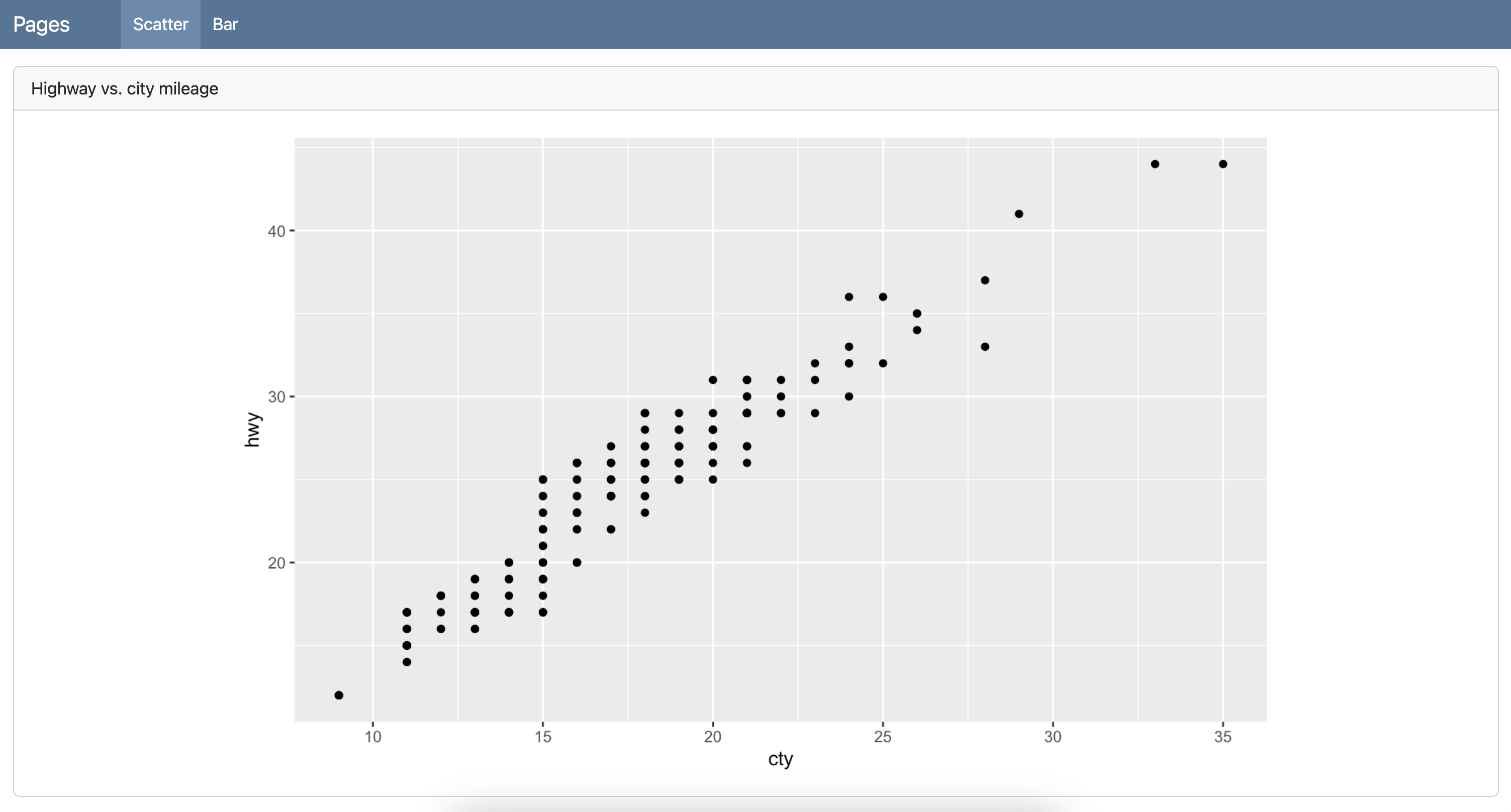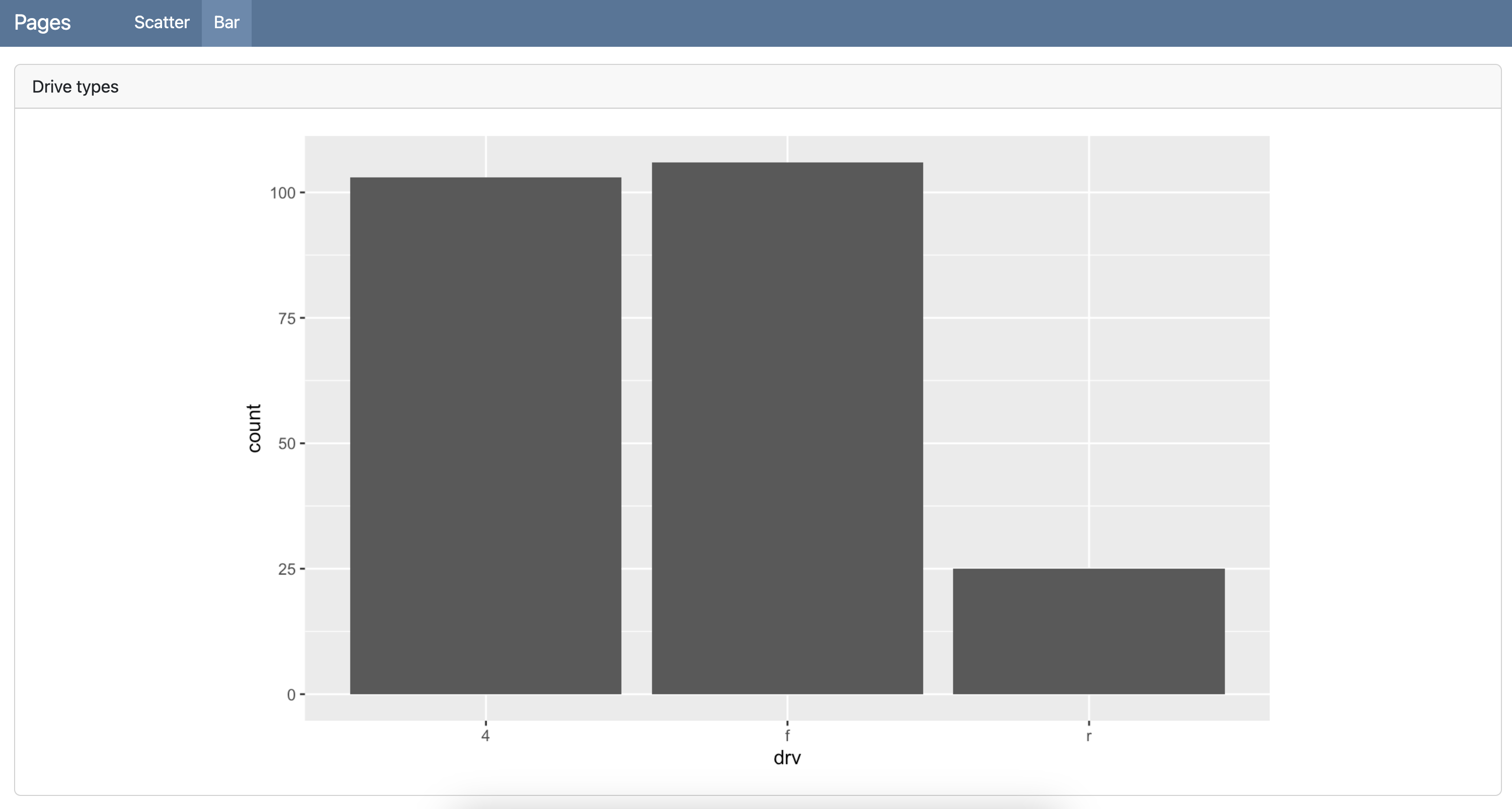Dashboard components
Build-a-Dashboard Workshop
Duke University
Posit, PBC
2024-08-12
Dashboard components
Navigation bar and pages
Icon, title, and author along with links to sub-pages if more than one page is defined.
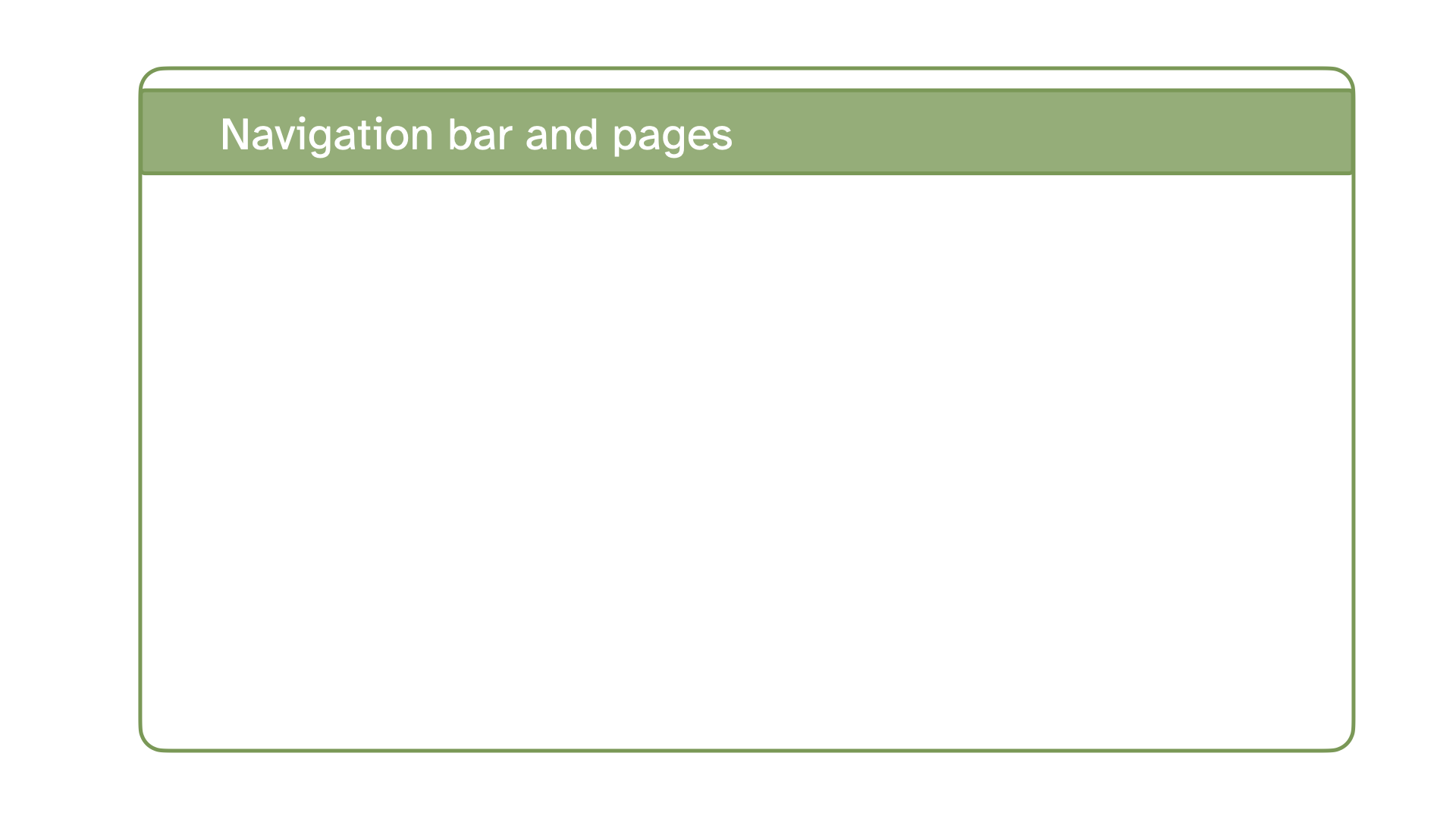
Sidebars, rows, columns, and tabsets
Rows and columns using markdown heading, with optional attributes to control height, width, etc. Sidebars, mostly used for for interactive inputs. Tabsets to further divide content.
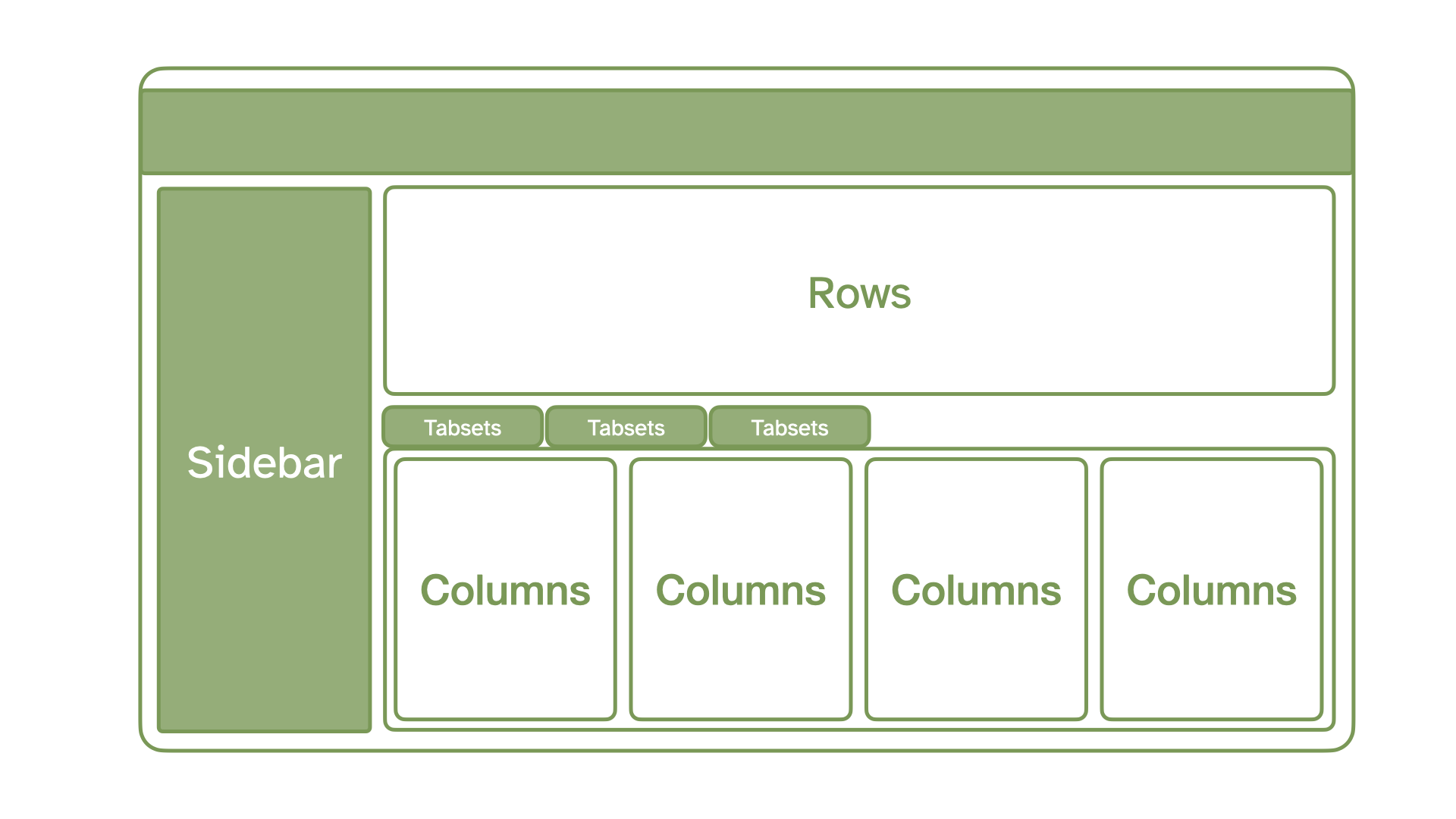
Cards
Cards are containers for code cell outputs (e.g., plots, tables, value boxes) and free form markdown text. The content of cards typically maps to cells in your notebook or source document.

A note on computing language
The examples in this module will primarily feature R code in code cells
All code in code cells can be replaced with Python, Julia, Observable, etc. and the layout would look exactly the same
When/if different behavior in layout is expected, this will be explicitly called out and examples in other computing languages will also be provided
Navigation bar and pages
Pages
Pages
Pages
Logo
Logo
Navigation buttons
dashboard-r.qmd
---
title: "Navigation buttons"
format:
dashboard:
logo: images/beetle.png
nav-buttons:
- icon: github
href: https://github.com/quarto-dev/quarto-cli
aria-label: GitHub
- icon: linkedin
href: https://www.linkedin.com/company/posit-software/
aria-label: LinkedIn
- icon: youtube
href: https://youtube.com/
aria-label: YouTube
---
```{r}
library(ggplot2)
```
# Scatter
```{r}
#| title: Highway vs. city mileage
ggplot(mpg, aes(x = cty, y = hwy)) +
geom_point()
```
# Bar
```{r}
#| title: Drive types
ggplot(mpg, aes(x = drv)) +
geom_bar()
```Navigation buttons
dashboard-r.qmd
---
title: "Navigation buttons"
format:
dashboard:
logo: images/beetle.png
nav-buttons:
- icon: github
href: https://github.com/quarto-dev/quarto-cli
aria-label: GitHub
- icon: linkedin
href: https://www.linkedin.com/company/posit-software/
aria-label: LinkedIn
- icon: youtube
href: https://youtube.com/
aria-label: YouTube
---
```{r}
library(ggplot2)
```
# Scatter
```{r}
#| title: Highway vs. city mileage
ggplot(mpg, aes(x = cty, y = hwy)) +
geom_point()
```
# Bar
```{r}
#| title: Drive types
ggplot(mpg, aes(x = drv)) +
geom_bar()
```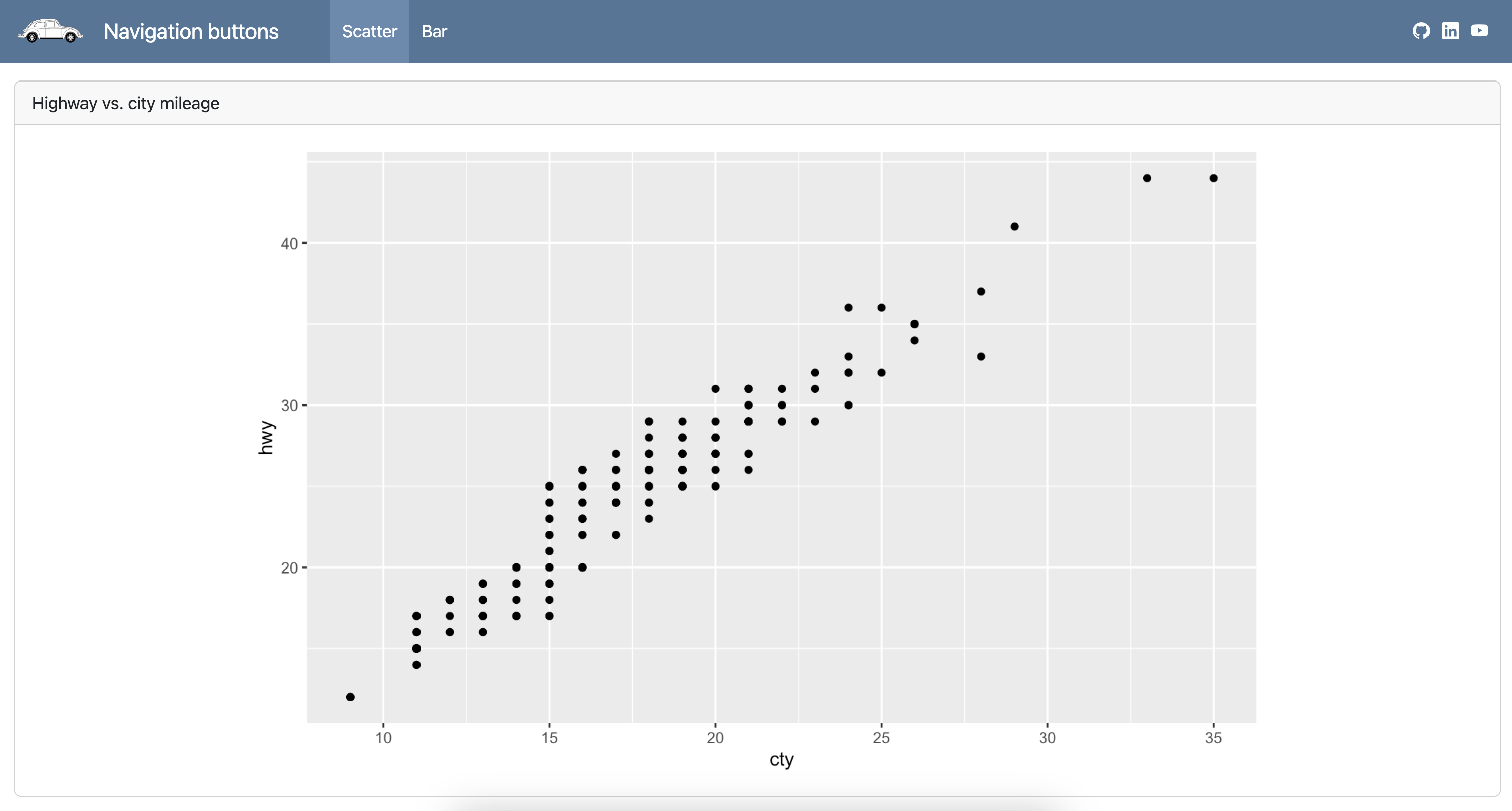
Navigation buttons – alternative
Special aliases are recognized for certain navigation buttons: linkedin, facebook, reddit, twitter, and github.
dashboard-r.qmd
---
title: "Navigation buttons - alternative"
format:
dashboard:
logo: images/beetle.png
nav-buttons: [linkedin]
linkedin: https://www.linkedin.com/company/posit-software
---
```{r}
library(ggplot2)
```
# Scatter
```{r}
#| title: Highway vs. city mileage
ggplot(mpg, aes(x = cty, y = hwy)) +
geom_point()
```
# Bar
```{r}
#| title: Drive types
ggplot(mpg, aes(x = drv)) +
geom_bar()
```Sidebars, rows, columns, and tabsets
Sidebars
For information about the dashboard, data, etc. and/or for user inputs in interactive dashboards
Can be at the global or page level
Sidebars - Global
dashboard-r.qmd
---
title: "Sidebars - Global"
format:
dashboard:
logo: images/beetle.png
nav-buttons:
- icon: github
href: https://github.com/quarto-dev/quarto-cli
aria-label: GitHub
- icon: linkedin
href: https://www.linkedin.com/company/posit-software/
aria-label: LinkedIn
- icon: youtube
href: https://youtube.com/
aria-label: YouTube
---
```{r}
library(ggplot2)
```
# {.sidebar}
Information and/or interactivity tools that you want on every page go here.
# Scatter
```{r}
#| title: Highway vs. city mileage
ggplot(mpg, aes(x = cty, y = hwy)) +
geom_point()
```
# Bar
```{r}
#| title: Drive types
ggplot(mpg, aes(x = drv)) +
geom_bar()
```Sidebars - Global
dashboard-r.qmd
---
title: "Sidebars - Global"
format:
dashboard:
logo: images/beetle.png
nav-buttons:
- icon: github
href: https://github.com/quarto-dev/quarto-cli
aria-label: GitHub
- icon: linkedin
href: https://www.linkedin.com/company/posit-software/
aria-label: LinkedIn
- icon: youtube
href: https://youtube.com/
aria-label: YouTube
---
```{r}
library(ggplot2)
```
# {.sidebar}
Information and/or interactivity tools that you want on every page go here.
# Scatter
```{r}
#| title: Highway vs. city mileage
ggplot(mpg, aes(x = cty, y = hwy)) +
geom_point()
```
# Bar
```{r}
#| title: Drive types
ggplot(mpg, aes(x = drv)) +
geom_bar()
```
Sidebars - Global
dashboard-r.qmd
---
title: "Sidebars - Global"
format:
dashboard:
logo: images/beetle.png
nav-buttons:
- icon: github
href: https://github.com/quarto-dev/quarto-cli
aria-label: GitHub
- icon: linkedin
href: https://www.linkedin.com/company/posit-software/
aria-label: LinkedIn
- icon: youtube
href: https://youtube.com/
aria-label: YouTube
---
```{r}
library(ggplot2)
```
# {.sidebar}
Information and/or interactivity tools that you want on every page go here.
# Scatter
```{r}
#| title: Highway vs. city mileage
ggplot(mpg, aes(x = cty, y = hwy)) +
geom_point()
```
# Bar
```{r}
#| title: Drive types
ggplot(mpg, aes(x = drv)) +
geom_bar()
```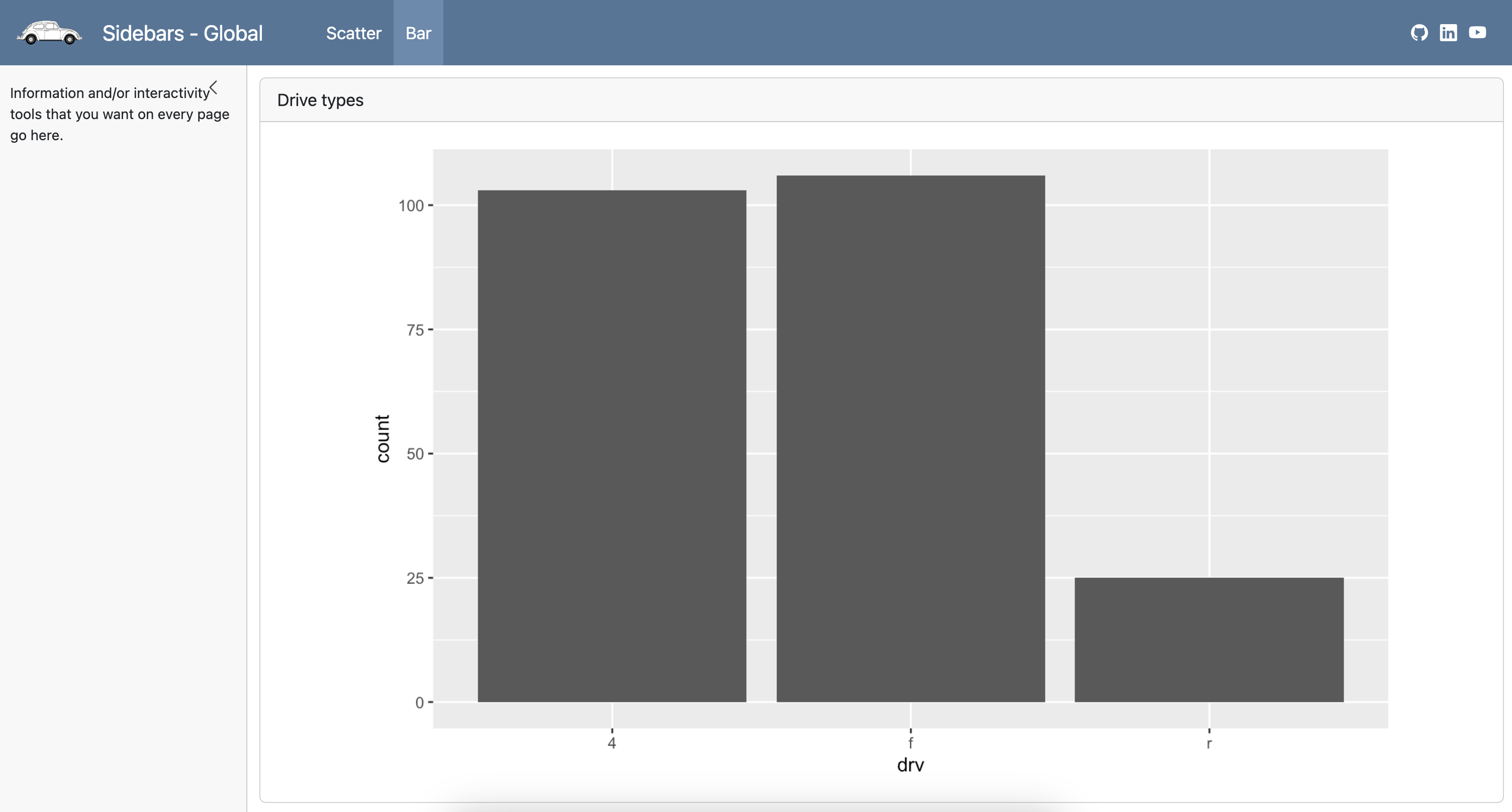
Sidebars - Page
dashboard-r.qmd
---
title: "Sidebars - Per page"
format:
dashboard:
logo: images/beetle.png
nav-buttons:
- icon: github
href: https://github.com/quarto-dev/quarto-cli
aria-label: GitHub
- icon: linkedin
href: https://www.linkedin.com/company/posit-software/
aria-label: LinkedIn
- icon: youtube
href: https://youtube.com/
aria-label: YouTube
---
```{r}
library(ggplot2)
```
# Scatter
## {.sidebar}
Information and/or interactivity tools that you want on a single page go here.
##
```{r}
#| title: Highway vs. city mileage
ggplot(mpg, aes(x = cty, y = hwy)) +
geom_point()
```
# Bar
```{r}
#| title: Drive types
ggplot(mpg, aes(x = drv)) +
geom_bar()
```Sidebars - Page
dashboard-r.qmd
---
title: "Sidebars - Per page"
format:
dashboard:
logo: images/beetle.png
nav-buttons:
- icon: github
href: https://github.com/quarto-dev/quarto-cli
aria-label: GitHub
- icon: linkedin
href: https://www.linkedin.com/company/posit-software/
aria-label: LinkedIn
- icon: youtube
href: https://youtube.com/
aria-label: YouTube
---
```{r}
library(ggplot2)
```
# Scatter
## {.sidebar}
Information and/or interactivity tools that you want on a single page go here.
##
```{r}
#| title: Highway vs. city mileage
ggplot(mpg, aes(x = cty, y = hwy)) +
geom_point()
```
# Bar
```{r}
#| title: Drive types
ggplot(mpg, aes(x = drv)) +
geom_bar()
```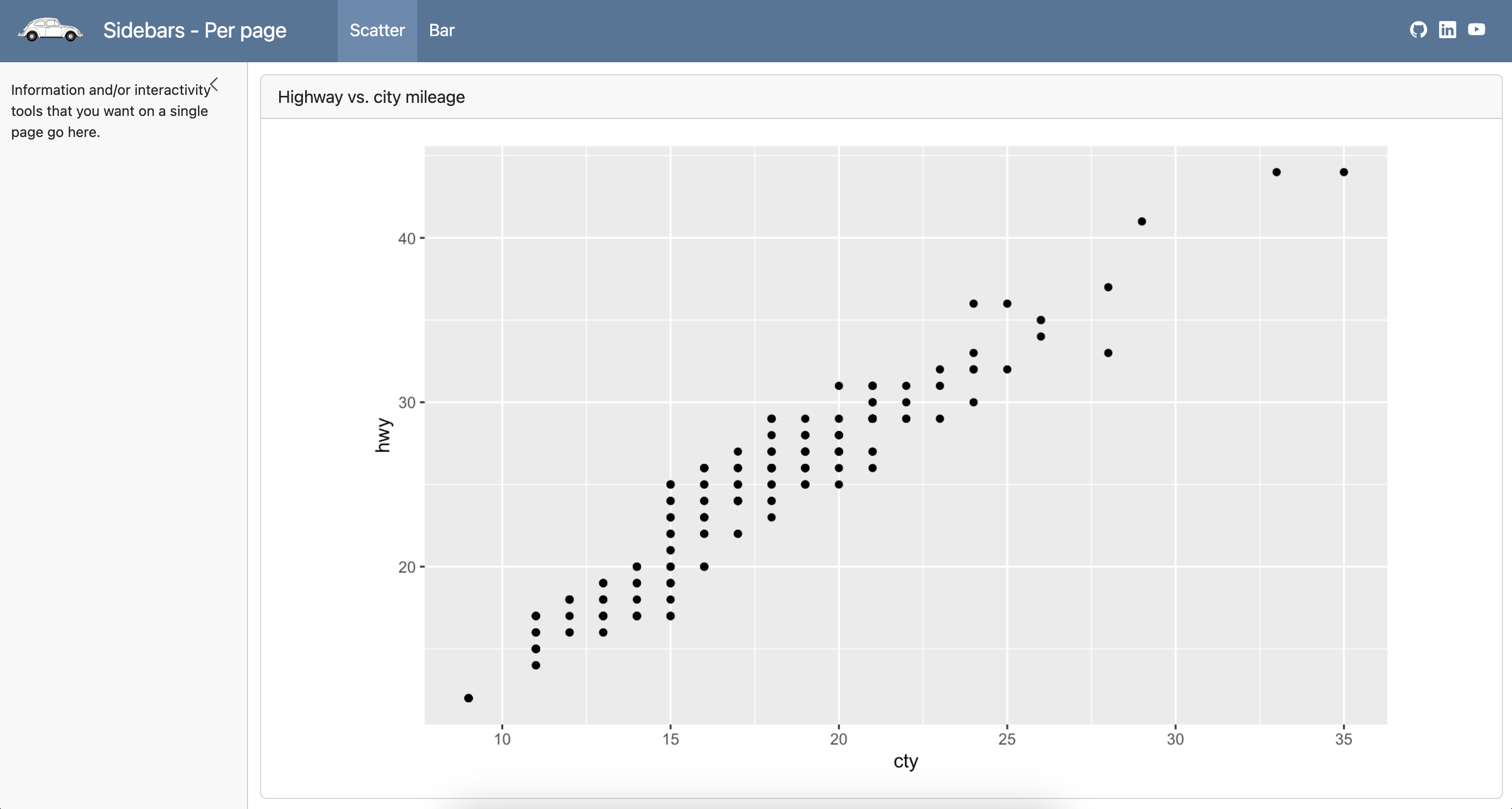
Sidebars - Page
dashboard-r.qmd
---
title: "Sidebars - Per page"
format:
dashboard:
logo: images/beetle.png
nav-buttons:
- icon: github
href: https://github.com/quarto-dev/quarto-cli
aria-label: GitHub
- icon: linkedin
href: https://www.linkedin.com/company/posit-software/
aria-label: LinkedIn
- icon: youtube
href: https://youtube.com/
aria-label: YouTube
---
```{r}
library(ggplot2)
```
# Scatter
## {.sidebar}
Information and/or interactivity tools that you want on a single page go here.
##
```{r}
#| title: Highway vs. city mileage
ggplot(mpg, aes(x = cty, y = hwy)) +
geom_point()
```
# Bar
```{r}
#| title: Drive types
ggplot(mpg, aes(x = drv)) +
geom_bar()
```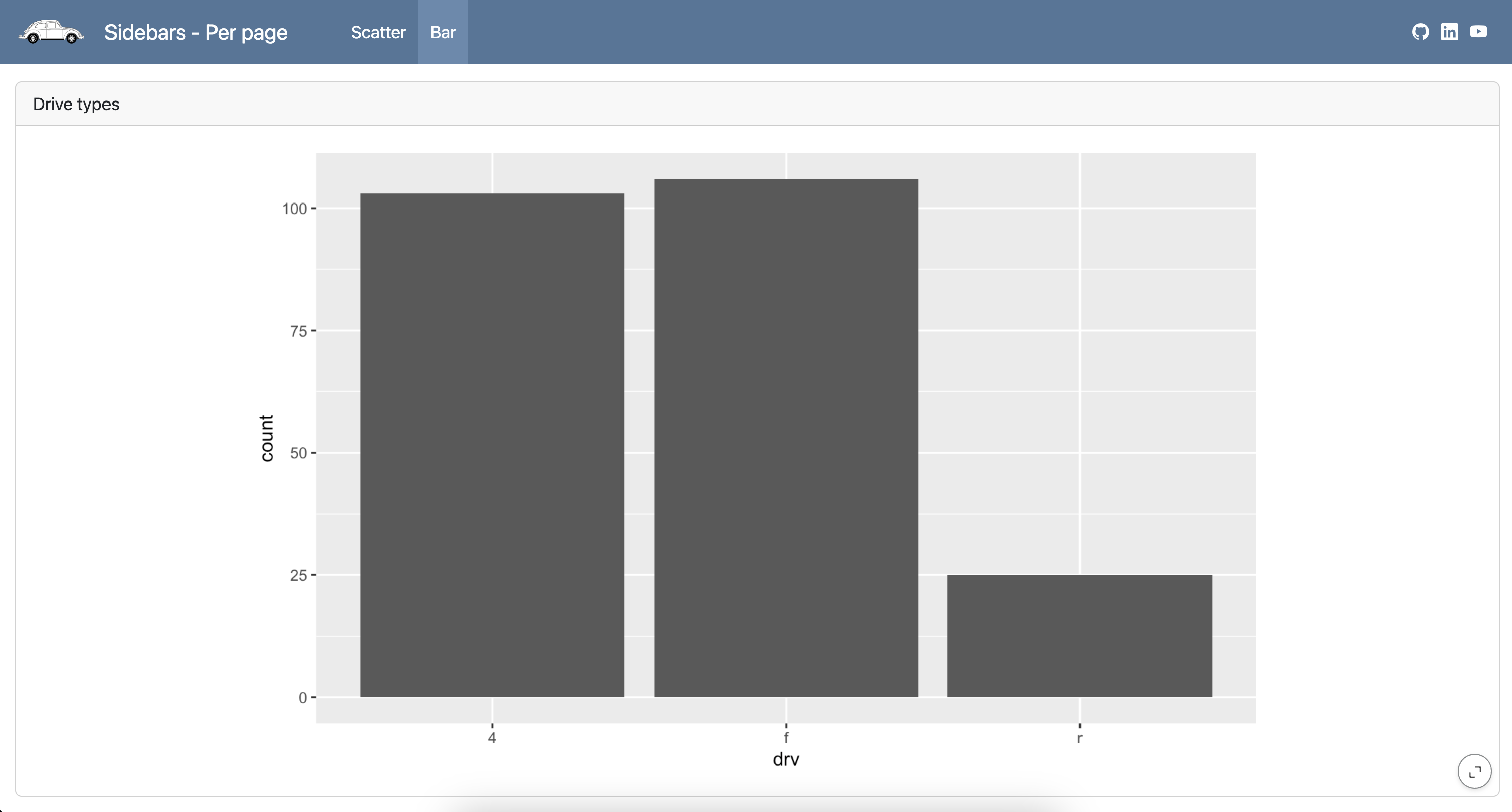
Rows
By default, cards are laid out in rows:
Rows
Rows
Default value of orientation is rows:
dashboard-r.qmd
Columns
Setting orientation to columns makes each ## indicate a column instead of a row:
dashboard-r.qmd
---
title: "Columns"
format:
dashboard:
orientation: columns
logo: images/beetle.png
---
```{r}
library(ggplot2)
```
## Scatter
```{r}
#| title: Highway vs. city mileage
ggplot(mpg, aes(x = cty, y = hwy)) +
geom_point()
```
## Bar
```{r}
#| title: Drive types
ggplot(mpg, aes(x = drv)) +
geom_bar()
```Columns
dashboard-r.qmd
---
title: "Columns"
format:
dashboard:
orientation: columns
logo: images/beetle.png
---
```{r}
library(ggplot2)
```
## Scatter
```{r}
#| title: Highway vs. city mileage
ggplot(mpg, aes(x = cty, y = hwy)) +
geom_point()
```
## Bar
```{r}
#| title: Drive types
ggplot(mpg, aes(x = drv)) +
geom_bar()
```
Rows, then columns
dashboard-r.qmd
---
title: "Rows, then columns"
format:
dashboard:
logo: images/beetle.png
---
```{r}
library(ggplot2)
```
## Overview
###
This dashboard summarizes an illuminating analysis of fuel economy of cars.
###
This is a car.
{fig-alt="Illustration of a teal color car."}
## Plots
### Scatter
```{r}
#| title: Highway vs. city mileage
ggplot(mpg, aes(x = cty, y = hwy)) +
geom_point()
```
### Bar
```{r}
#| title: Drive types
ggplot(mpg, aes(x = drv)) +
geom_bar()
```Rows, then columns
dashboard-r.qmd
---
title: "Rows, then columns"
format:
dashboard:
logo: images/beetle.png
---
```{r}
library(ggplot2)
```
## Overview
###
This dashboard summarizes an illuminating analysis of fuel economy of cars.
###
This is a car.
{fig-alt="Illustration of a teal color car."}
## Plots
### Scatter
```{r}
#| title: Highway vs. city mileage
ggplot(mpg, aes(x = cty, y = hwy)) +
geom_point()
```
### Bar
```{r}
#| title: Drive types
ggplot(mpg, aes(x = drv)) +
geom_bar()
```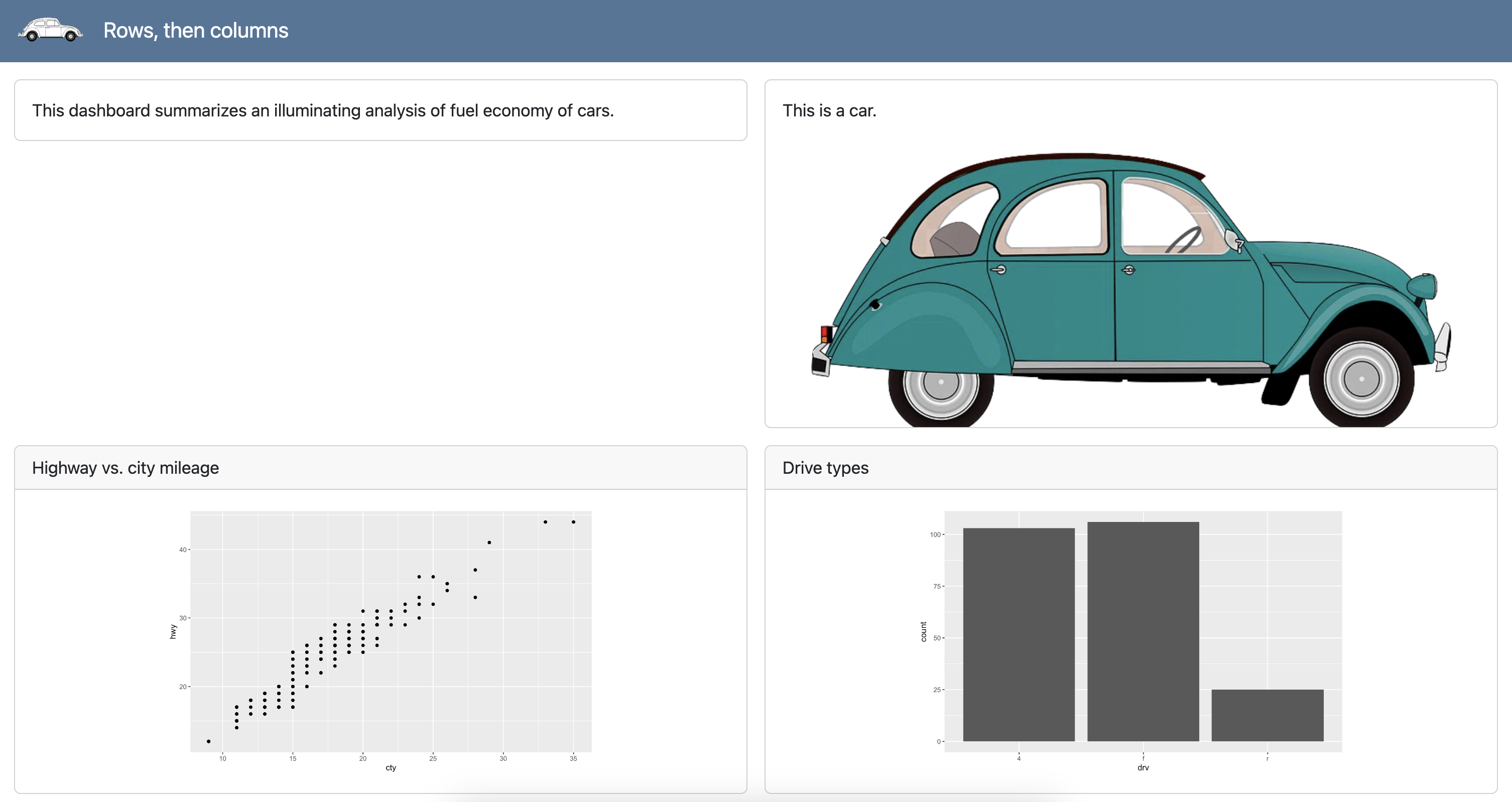
Columns, then rows
dashboard-r.qmd
---
title: "Rows, then columns"
format:
dashboard:
orientation: columns
logo: images/beetle.png
---
```{r}
library(ggplot2)
```
## Overview
###
This dashboard summarizes an illuminating analysis of fuel economy of cars.
###
This is a car.
{fig-alt="Illustration of a teal color car."}
## Plots
### Scatter
```{r}
#| title: Highway vs. city mileage
ggplot(mpg, aes(x = cty, y = hwy)) +
geom_point()
```
### Bar
```{r}
#| title: Drive types
ggplot(mpg, aes(x = drv)) +
geom_bar()
```Columns, then rows
dashboard-r.qmd
---
title: "Rows, then columns"
format:
dashboard:
orientation: columns
logo: images/beetle.png
---
```{r}
library(ggplot2)
```
## Overview
###
This dashboard summarizes an illuminating analysis of fuel economy of cars.
###
This is a car.
{fig-alt="Illustration of a teal color car."}
## Plots
### Scatter
```{r}
#| title: Highway vs. city mileage
ggplot(mpg, aes(x = cty, y = hwy)) +
geom_point()
```
### Bar
```{r}
#| title: Drive types
ggplot(mpg, aes(x = drv)) +
geom_bar()
```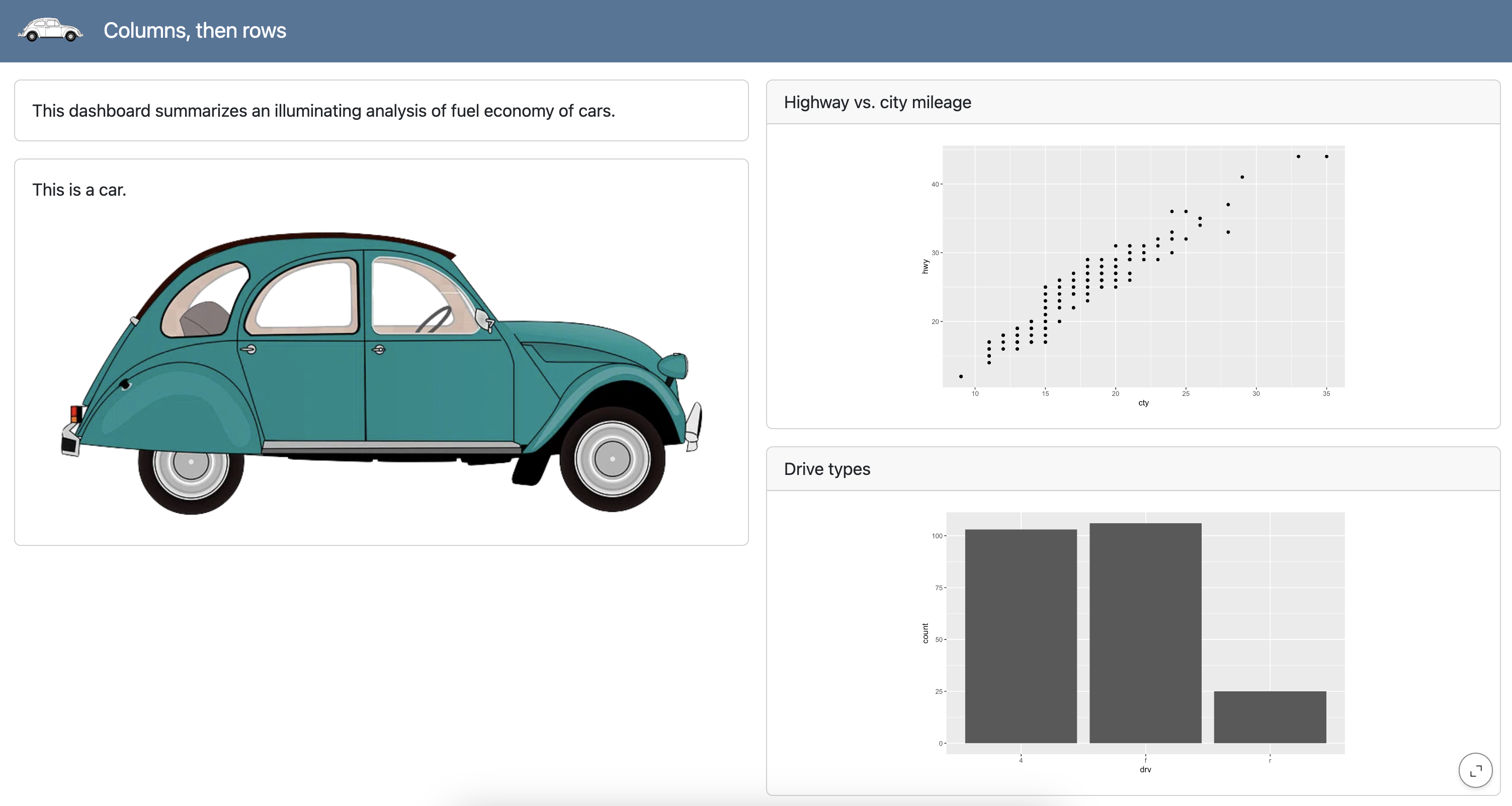
Heights and widths of rows and columns
dashboard-r.qmd
---
title: "Rows, then columns"
format:
dashboard:
logo: images/beetle.png
---
```{r}
library(ggplot2)
```
## Overview {height="30%"}
### {width="20%"}
This dashboard summarizes an illuminating analysis of fuel economy of cars.
### {width="80%"}
This is a car.
{fig-alt="Illustration of a teal color car." width="300"}
## Plots {height="70%"}
### Scatter {width="75%"}
```{r}
#| title: Highway vs. city mileage
ggplot(mpg, aes(x = cty, y = hwy)) +
geom_point()
```
### Bar {width="25%"}
```{r}
#| title: Drive types
ggplot(mpg, aes(x = drv)) +
geom_bar()
```Heights and widths of rows and columns
dashboard-r.qmd
---
title: "Rows, then columns"
format:
dashboard:
logo: images/beetle.png
---
```{r}
library(ggplot2)
```
## Overview {height="30%"}
### {width="20%"}
This dashboard summarizes an illuminating analysis of fuel economy of cars.
### {width="80%"}
This is a car.
{fig-alt="Illustration of a teal color car." width="300"}
## Plots {height="70%"}
### Scatter {width="75%"}
```{r}
#| title: Highway vs. city mileage
ggplot(mpg, aes(x = cty, y = hwy)) +
geom_point()
```
### Bar {width="25%"}
```{r}
#| title: Drive types
ggplot(mpg, aes(x = drv)) +
geom_bar()
```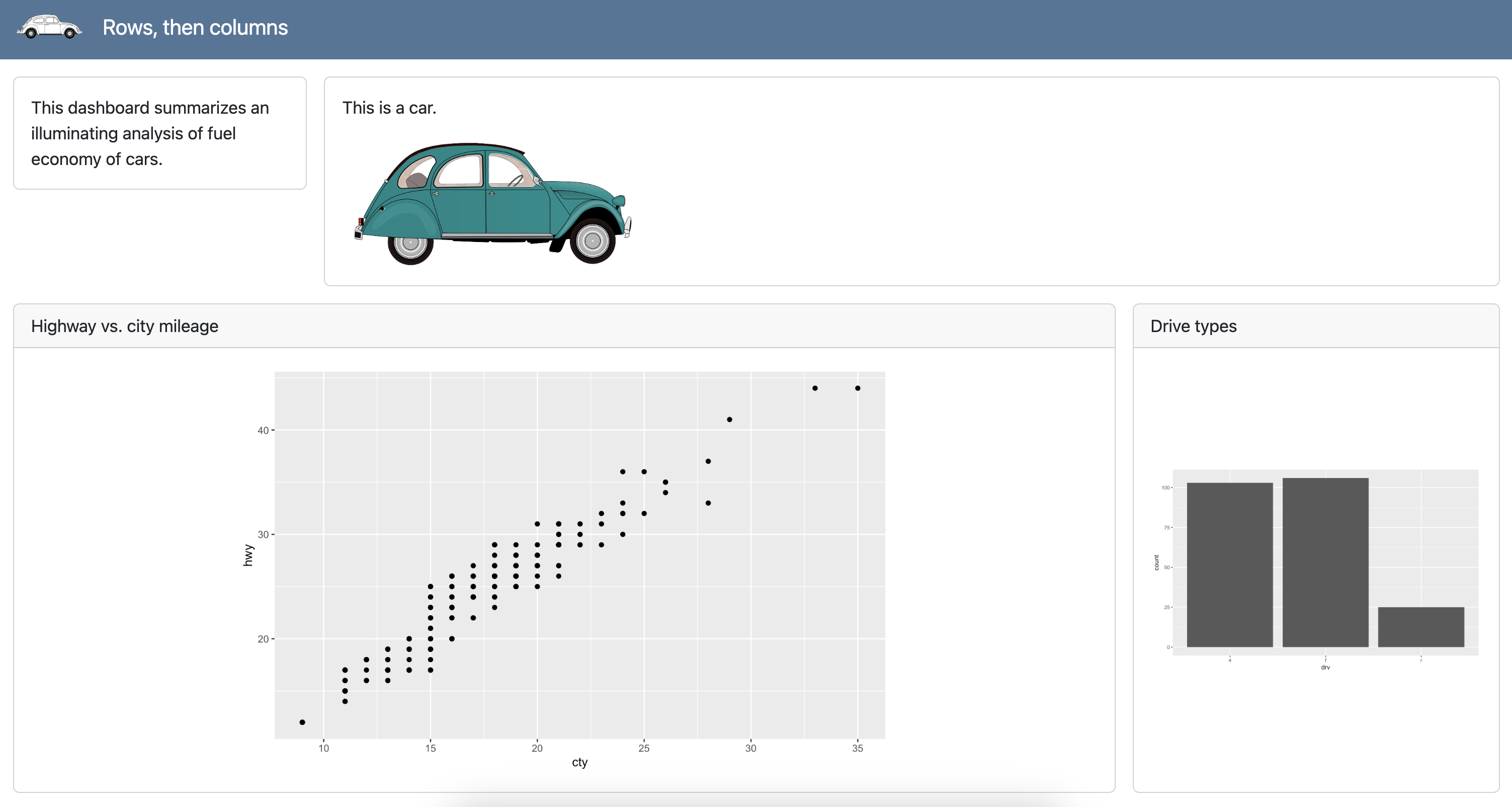
fill vs. flow
Each row in a dashboard that is not given an explicit height will determine its size by either
filling available space or byflowing to its natural heightfillling layout is generally the default, however for certain types of content (e.g., markdown text)flowlayout is the default.If the default behavior is not what you want, you can explicitly specify filling or flowing behavior using the
.filland.flowclasses applied to a row.
scrolling
Need more space? Set scrolling: true for accommodate page overflow.
Note
This option is handy for adding more rows of cards to a dashboard, however spreading content across pages and tabsets can be a better way to present information.
Per page controls
orientation and scrolling can be provided at the dashboard or page level:
dashboard-r.qmd
---
title: "Rows, then columns"
format:
dashboard:
logo: images/beetle.png
---
```{r}
library(ggplot2)
```
## Overview {orientation="rows"}
###
This dashboard summarizes an illuminating analysis of fuel economy of cars.
###
This is a car.
{fig-alt="Illustration of a teal color car."}
## Plots {orientation="columns" scrolling="true"}
### Scatter
```{r}
#| title: Highway vs. city mileage
ggplot(mpg, aes(x = cty, y = hwy)) +
geom_point()
```
### Bar
```{r}
#| title: Drive types
ggplot(mpg, aes(x = drv)) +
geom_bar()
```Tabsets
dashboard-r.qmd
---
title: "Tabsets"
format:
dashboard:
logo: images/beetle.png
---
```{r}
library(ggplot2)
```
## Overview {.tabset}
### Objective
This dashboard summarizes an illuminating analysis of fuel economy of cars.
### Car
This is a car.
{fig-alt="Illustration of a teal color car." width="299"}
## Plots {.tabset}
### Scatter
```{r}
#| title: Highway vs. city mileage
ggplot(mpg, aes(x = cty, y = hwy)) +
geom_point()
```
### Bar
```{r}
#| title: Drive types
ggplot(mpg, aes(x = drv)) +
geom_bar()
```Tabsets
Each card within a row/column or each row/column within another becomes a tab:
dashboard-r.qmd
---
title: "Tabsets"
format:
dashboard:
logo: images/beetle.png
---
```{r}
library(ggplot2)
```
## Overview {.tabset}
### Objective
This dashboard summarizes an illuminating analysis of fuel economy of cars.
### Car
This is a car.
{fig-alt="Illustration of a teal color car." width="299"}
## Plots {.tabset}
### Scatter
```{r}
#| title: Highway vs. city mileage
ggplot(mpg, aes(x = cty, y = hwy)) +
geom_point()
```
### Bar
```{r}
#| title: Drive types
ggplot(mpg, aes(x = drv)) +
geom_bar()
```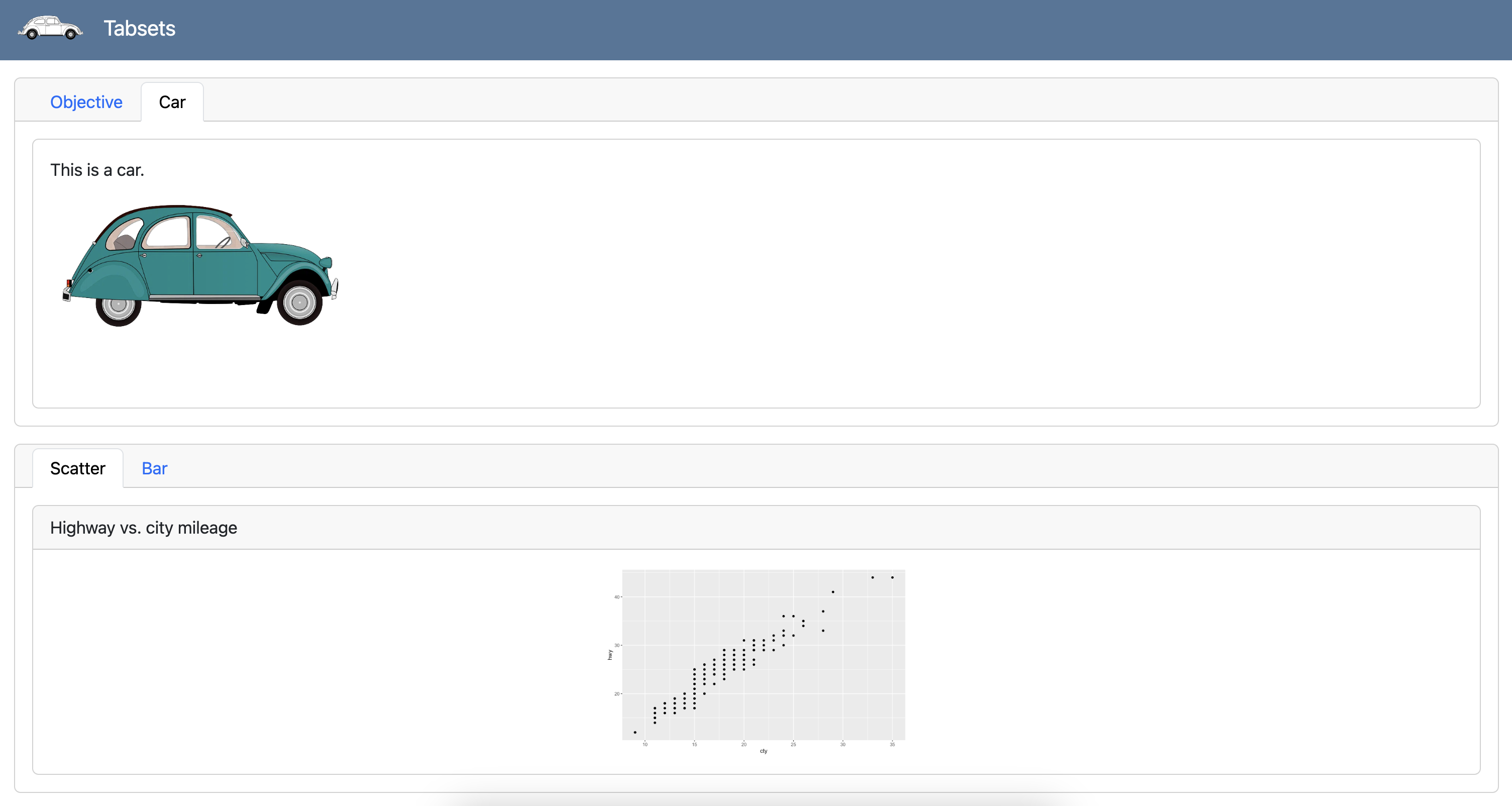
Cards
Cards
Fundamental unit of display within dashboards
Created automatically for cells and markdown content that are within rows and columns
Can be created manually with a
carddiv:Cards provide an expand button which appears at bottom right on hover
Card titles
Card titles can be provided as a cell option or within a cat() (R) or print() (Python) statement:
dashboard-r.qmd
---
title: "Card titles"
format:
dashboard:
logo: images/beetle.png
---
```{r}
library(ggplot2)
```
```{r}
#| title: Highway vs. city mileage
ggplot(mpg, aes(x = cty, y = hwy)) +
geom_point()
```
```{r}
n_cars <- nrow(mpg)
cat("title=", "Drive types of", n_cars, "cars")
ggplot(mpg, aes(x = drv)) +
geom_bar()
```Card titles
dashboard-r.qmd
---
title: "Card titles"
format:
dashboard:
logo: images/beetle.png
---
```{r}
library(ggplot2)
```
```{r}
#| title: Highway vs. city mileage
ggplot(mpg, aes(x = cty, y = hwy)) +
geom_point()
```
```{r}
n_cars <- nrow(mpg)
cat("title=", "Drive types of", n_cars, "cars")
ggplot(mpg, aes(x = drv)) +
geom_bar()
```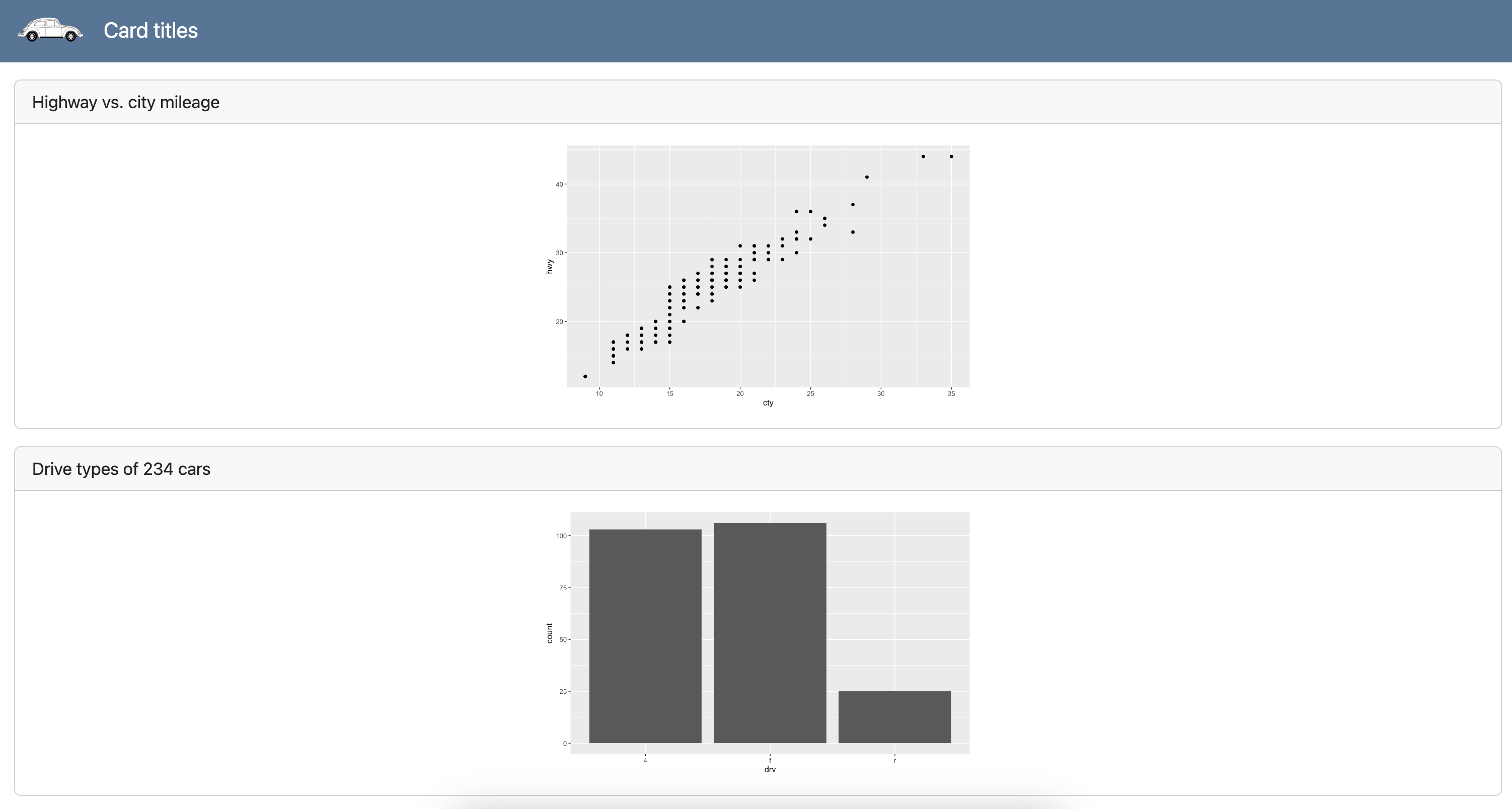
Pop quiz!
Which of the following cells will become a card in a dashboard?
Multiple outputs
If a cell generates multiple outputs, they get wrapped in a single cell:
Multiple outputs
Multiple output layout
You can control layout of multiple outputs with layout-ncol:
Multiple output layout
Value boxes
Value boxes are a great way to prominently display simple values within a dashboard
You can create value boxes in executable cells or plain markdown in divs
Value boxes use Bootstrap icons (https://icons.getbootstrap.com) and can be set to any color (e.g., with a HEX code) or color alias defined by the theme (we’ll get to themes later!)
Color alias Default theme color(s) primaryBlue secondaryGray successGreen infoBright Blue warningYellow/Orange dangerRed lightLight Gray darkBlack
Value boxes
dashboard-r.qmd
---
title: "Valueboxes"
format: dashboard
---
```{r}
library(ggplot2)
library(dplyr)
```
## Value boxes {height="25%"}
```{r}
#| label: calculate-values
lowest_mileage_cty <- mpg |>
filter(cty == min(cty)) |>
distinct(cty) |>
pull(cty)
highest_mileage_cty <- mpg |>
filter(cty == max(cty)) |>
distinct(cty) |>
pull(cty)
rounded_mean_city_mileage <- mpg |>
summarize(round(mean(cty), 2)) |>
pull()
```
```{r}
#| content: valuebox
#| title: "Least efficient"
#| icon: fuel-pump-fill
#| color: danger
list(
value = paste(lowest_mileage_cty, "mpg")
)
```
```{r}
#| content: valuebox
#| title: "Most efficient"
list(
icon = "fuel-pump",
color = "success",
value = paste(highest_mileage_cty, "mpg")
)
```
::: {.valuebox icon="fuel-pump" color="secondary"}
Average city mileage
`{r} rounded_mean_city_mileage` mpg
:::
## Plots {height="75%"}
```{r}
#| title: Highway vs. city mileage
ggplot(mpg, aes(x = cty, y = hwy)) +
geom_point()
```
```{r}
#| title: Drive types
ggplot(mpg, aes(x = drv)) +
geom_bar()
```Value boxes
dashboard-r.qmd
---
title: "Valueboxes"
format: dashboard
---
```{r}
library(ggplot2)
library(dplyr)
```
## Value boxes {height="25%"}
```{r}
#| label: calculate-values
lowest_mileage_cty <- mpg |>
filter(cty == min(cty)) |>
distinct(cty) |>
pull(cty)
highest_mileage_cty <- mpg |>
filter(cty == max(cty)) |>
distinct(cty) |>
pull(cty)
rounded_mean_city_mileage <- mpg |>
summarize(round(mean(cty), 2)) |>
pull()
```
```{r}
#| content: valuebox
#| title: "Least efficient"
#| icon: fuel-pump-fill
#| color: danger
list(
value = paste(lowest_mileage_cty, "mpg")
)
```
```{r}
#| content: valuebox
#| title: "Most efficient"
list(
icon = "fuel-pump",
color = "success",
value = paste(highest_mileage_cty, "mpg")
)
```
::: {.valuebox icon="fuel-pump" color="secondary"}
Average city mileage
`{r} rounded_mean_city_mileage` mpg
:::
## Plots {height="75%"}
```{r}
#| title: Highway vs. city mileage
ggplot(mpg, aes(x = cty, y = hwy)) +
geom_point()
```
```{r}
#| title: Drive types
ggplot(mpg, aes(x = drv)) +
geom_bar()
```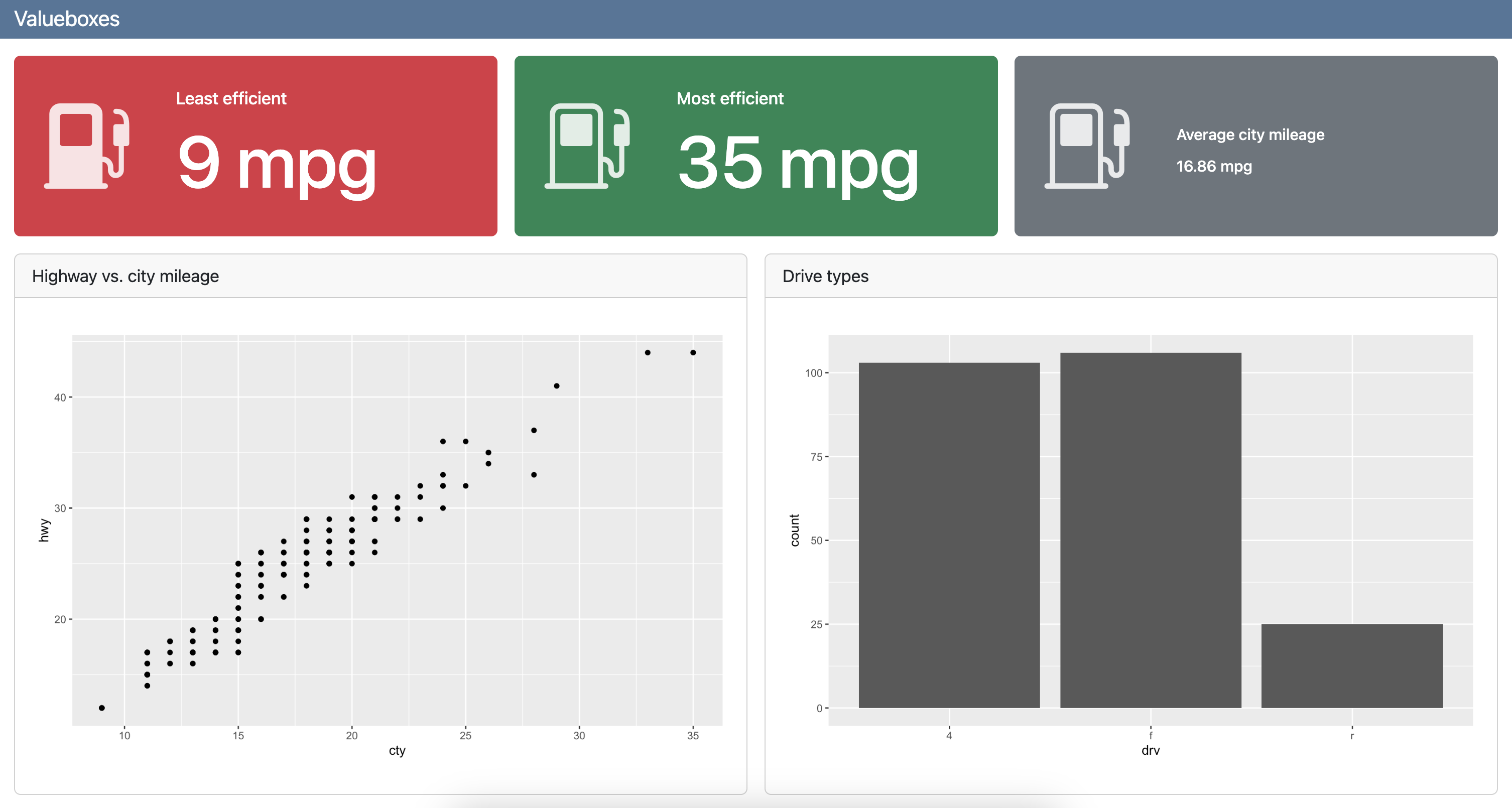
Value boxes
dashboard-py.qmd
---
title: "Valueboxes"
format: dashboard
---
```{python}
from plotnine import ggplot, aes, geom_point, geom_bar
from plotnine.data import mpg
```
## Value boxes {height="25%"}
```{python}
#| label: calculate-values
lowest_mileage_index = mpg['cty'].idxmin()
lowest_mileage_car = mpg.iloc[lowest_mileage_index]
lowest_mileage_cty = mpg.loc[lowest_mileage_index, 'cty']
highest_mileage_index = mpg['cty'].idxmax()
highest_mileage_car = mpg.iloc[highest_mileage_index]
highest_mileage_cty = mpg.loc[highest_mileage_index, 'cty']
mean_city_mileage = mpg['cty'].mean()
rounded_mean_city_mileage = round(mean_city_mileage, 2)
```
```{python}
#| content: valuebox
#| title: "Least efficient"
#| icon: fuel-pump-fill
#| color: danger
dict(
value = str(f"{lowest_mileage_cty} mpg")
)
```
```{python}
#| content: valuebox
#| title: "Most efficient"
dict(
icon = "fuel-pump",
color = "success",
value = str(f"{highest_mileage_cty} mpg")
)
```
::: {.valuebox icon="fuel-pump" color="secondary"}
Average city mileage
`{python} str(rounded_mean_city_mileage)` mpg
:::
## Plots {height="75%"}
```{python}
#| title: Highway vs. city mileage
(
ggplot(mpg, aes(x = "cty", y = "hwy"))
+ geom_point()
)
```
```{python}
#| title: Drive types
(
ggplot(mpg, aes(x = "drv"))
+ geom_bar()
)
```Value boxes
dashboard-py.qmd
---
title: "Valueboxes"
format: dashboard
---
```{python}
from plotnine import ggplot, aes, geom_point, geom_bar
from plotnine.data import mpg
```
## Value boxes {height="25%"}
```{python}
#| label: calculate-values
lowest_mileage_index = mpg['cty'].idxmin()
lowest_mileage_car = mpg.iloc[lowest_mileage_index]
lowest_mileage_cty = mpg.loc[lowest_mileage_index, 'cty']
highest_mileage_index = mpg['cty'].idxmax()
highest_mileage_car = mpg.iloc[highest_mileage_index]
highest_mileage_cty = mpg.loc[highest_mileage_index, 'cty']
mean_city_mileage = mpg['cty'].mean()
rounded_mean_city_mileage = round(mean_city_mileage, 2)
```
```{python}
#| content: valuebox
#| title: "Least efficient"
#| icon: fuel-pump-fill
#| color: danger
dict(
value = str(f"{lowest_mileage_cty} mpg")
)
```
```{python}
#| content: valuebox
#| title: "Most efficient"
dict(
icon = "fuel-pump",
color = "success",
value = str(f"{highest_mileage_cty} mpg")
)
```
::: {.valuebox icon="fuel-pump" color="secondary"}
Average city mileage
`{python} str(rounded_mean_city_mileage)` mpg
:::
## Plots {height="75%"}
```{python}
#| title: Highway vs. city mileage
(
ggplot(mpg, aes(x = "cty", y = "hwy"))
+ geom_point()
)
```
```{python}
#| title: Drive types
(
ggplot(mpg, aes(x = "drv"))
+ geom_bar()
)
```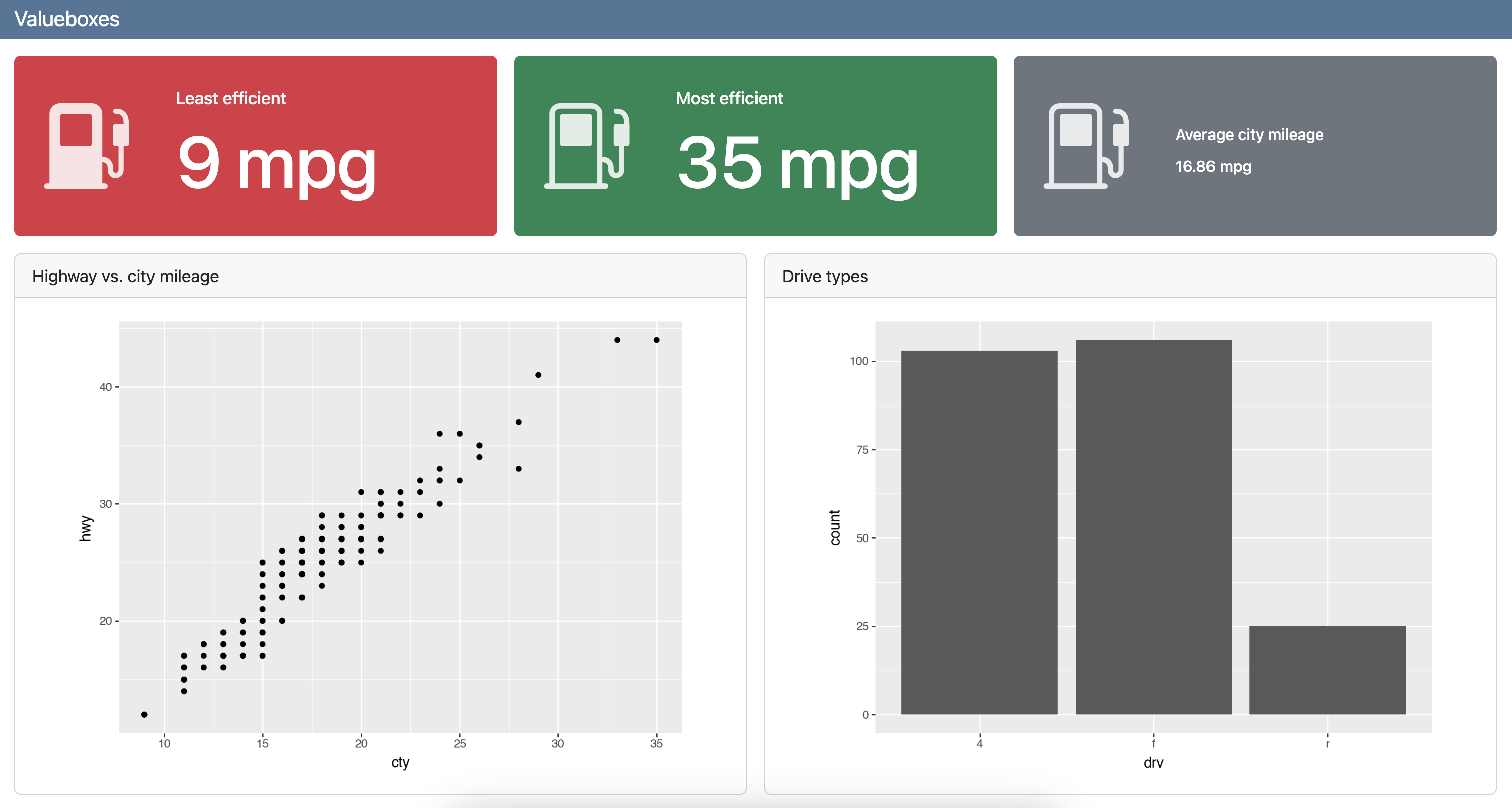
Markdown text
You can include markdown text anywhere within a dashboard
Markdown text is automatically placed in cards, but you can also explicitly put them in cards with fenced divs, and add titles to cards
You can place markdown text and other cell output in a single card as well
Your turn
Start
Option 1 - Cloud: Go to Posit Cloud for the workshop, open project titled
2 - Dashboards components.Option 2 - Local: Clone the GitHub repo
posit-conf-2024/olympicdash(https://github.com/posit-conf-2024/olympicdash) and work onolympicdash-r-2.qmd.
Python - Local: Clone the GitHub repo posit-conf-2024/olympicdash (https://github.com/posit-conf-2024/olympicdash) and work on olympicdash-py-2.qmd.
Goal
Your goal is to create a dashboard that looks like the following:
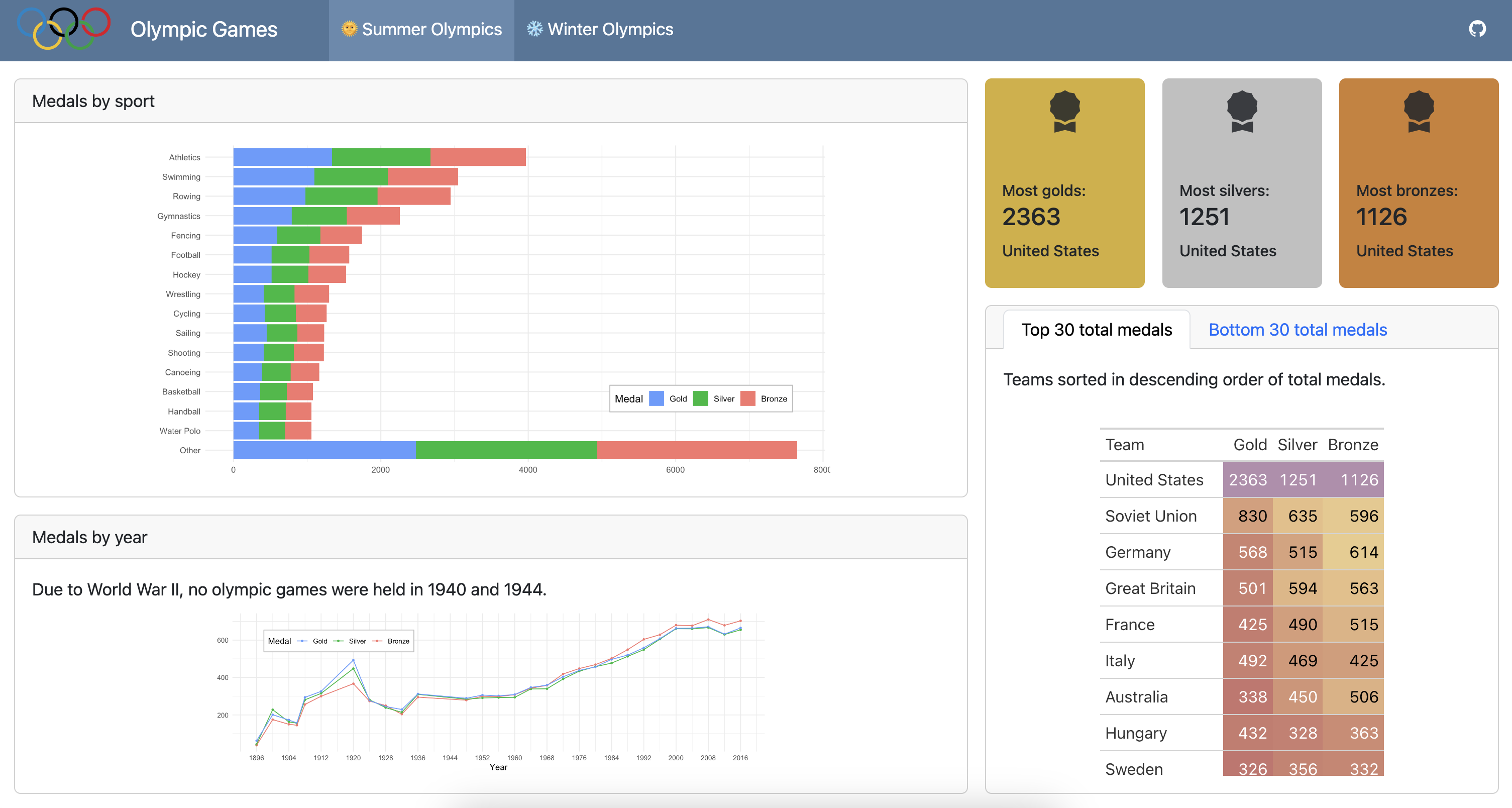
Step 1
- Add two pages - one for Summer Olympics and one for Winter Olympics.
- Duplicate existing dashboard content for the two types of olympic games with subsets of data from the corresponding season.
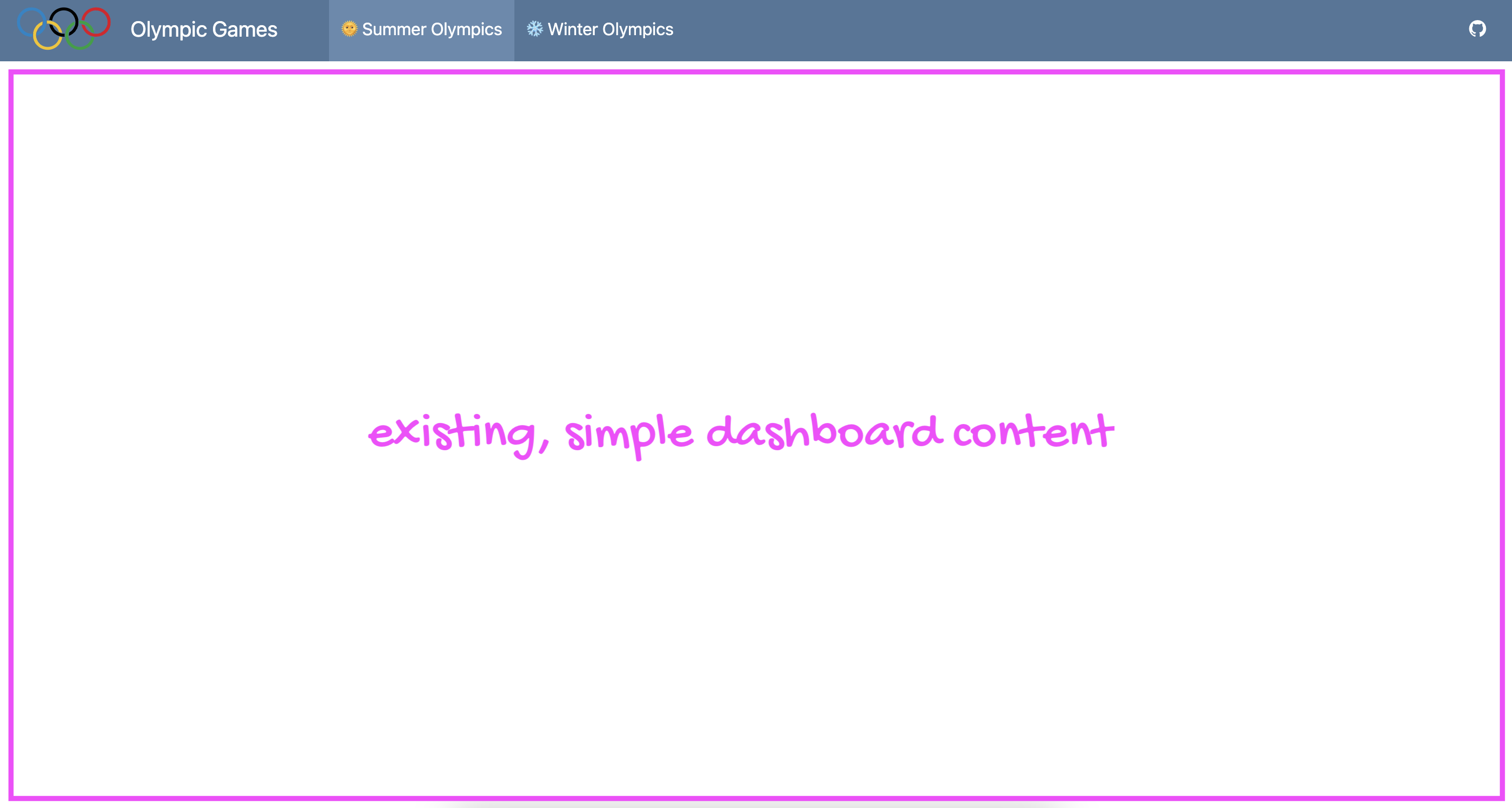
05:00
Step 2
In the Summer Olympics page:
- Make the columns 65% (first) and 35% (second) of width of the dashboard.
- Divide the first column into rows of 60% (first) and 40% (second) of height of the dashboard.
- In the second row of the first column, combine markdown text about cancelled olympic games with the medals by year plot in the same cell.
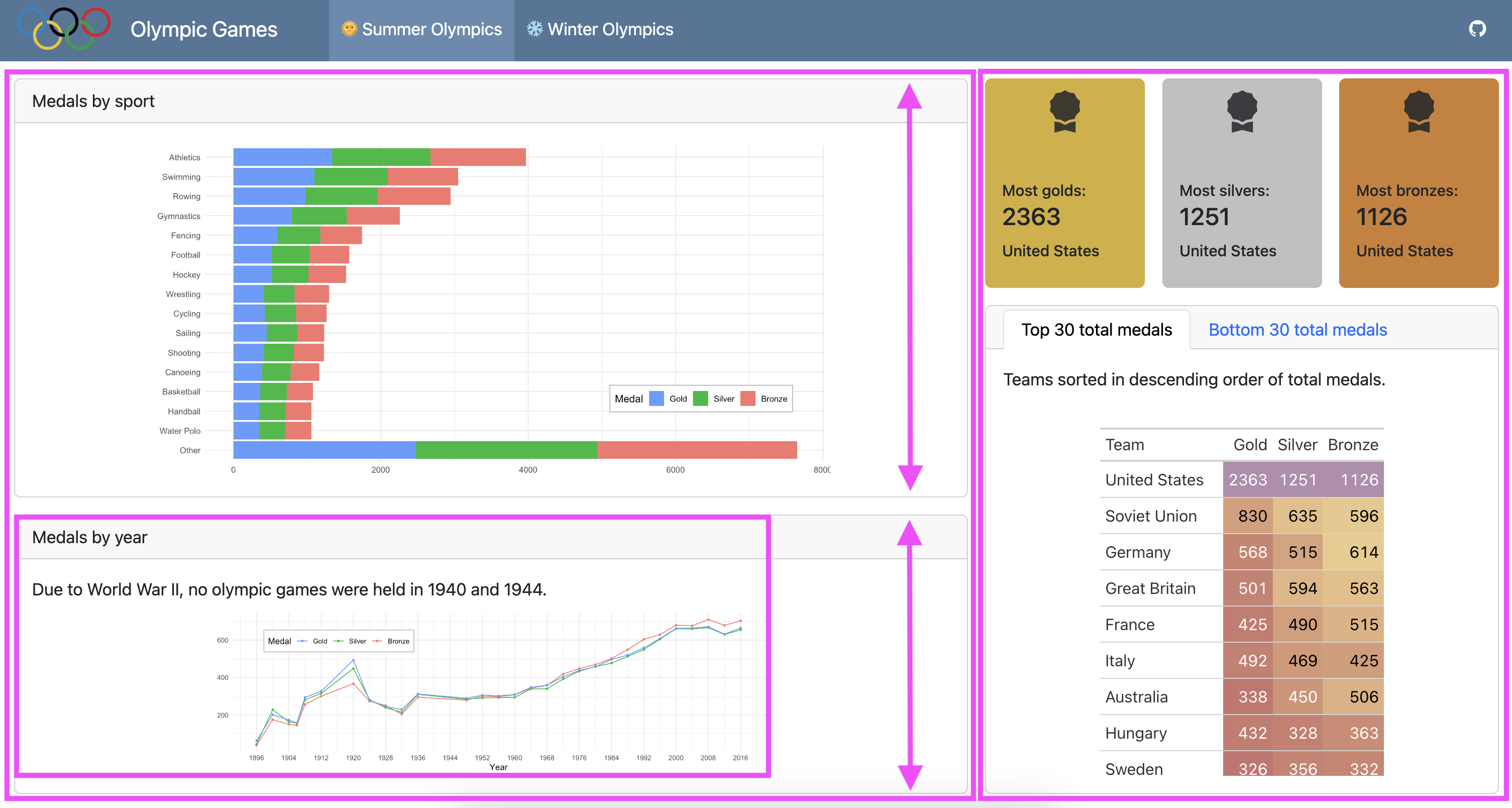
05:00
Step 3
In the Summer Olympics page:
- Divide the second column into rows of 25% (first) and 75% (second) of height of the dashboard.
- In the second row of the second column, create tables (using gt for R or great_tables for Python) of top 30 and bottom 30 total medals by team, sorted in descending order for the top 30 and ascending order for the bottom 30 total medals, and add color to the table based on data values.
- Place these tables in tabsets with descriptive text about table content in the same card/tab.
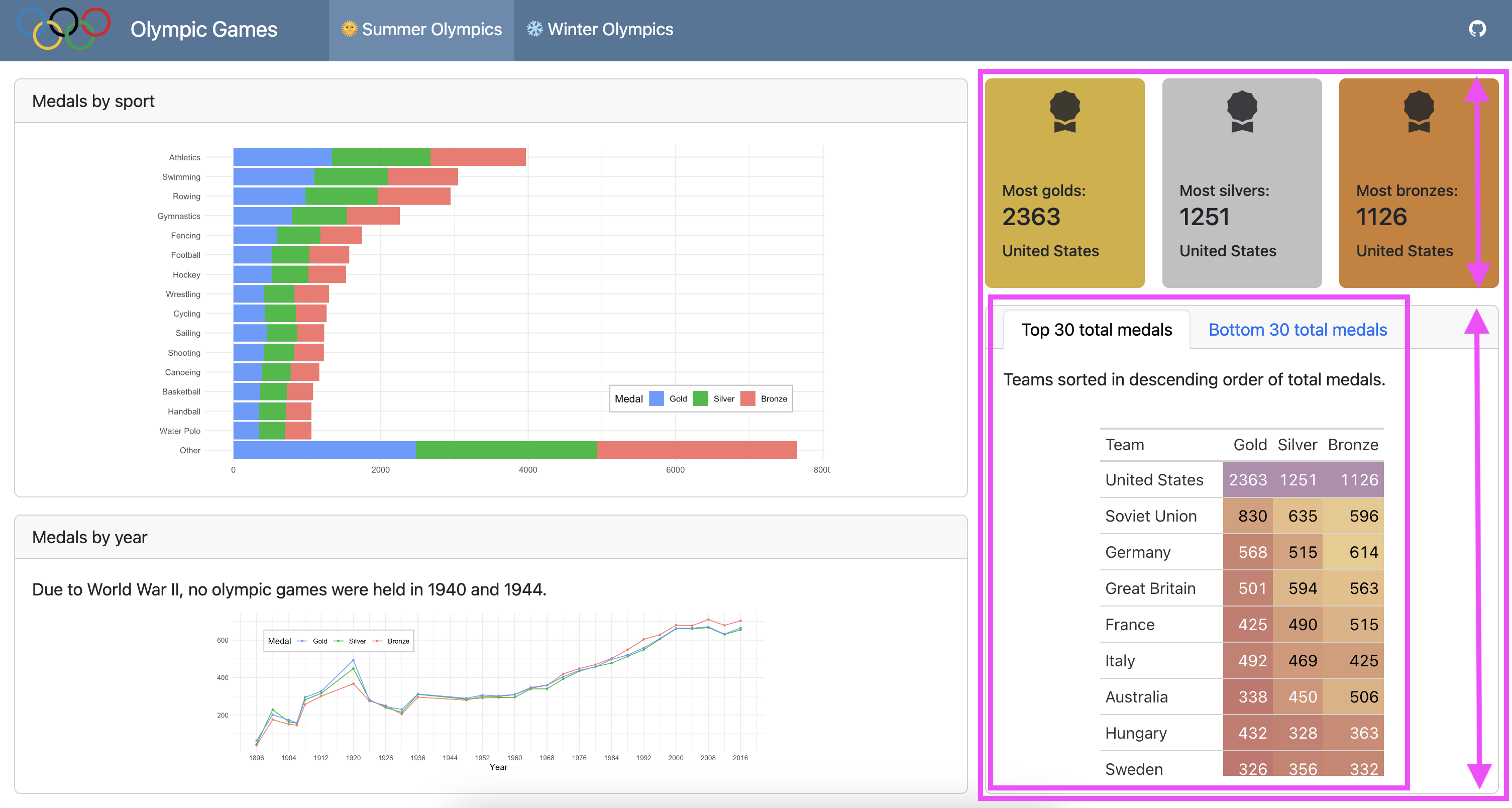
10:00
Step 4
In the first row of the second column of the Summer Olympics page, add value boxes for highest numbers of gold, silver, and bronze medals with appropriate color for each medal and using the award-fill icon.

10:00
Step 5
Duplicate dashboard content for the Winter Olympics page, share your results with your neighbor, and discuss approaches for not repeating yourself in your code.
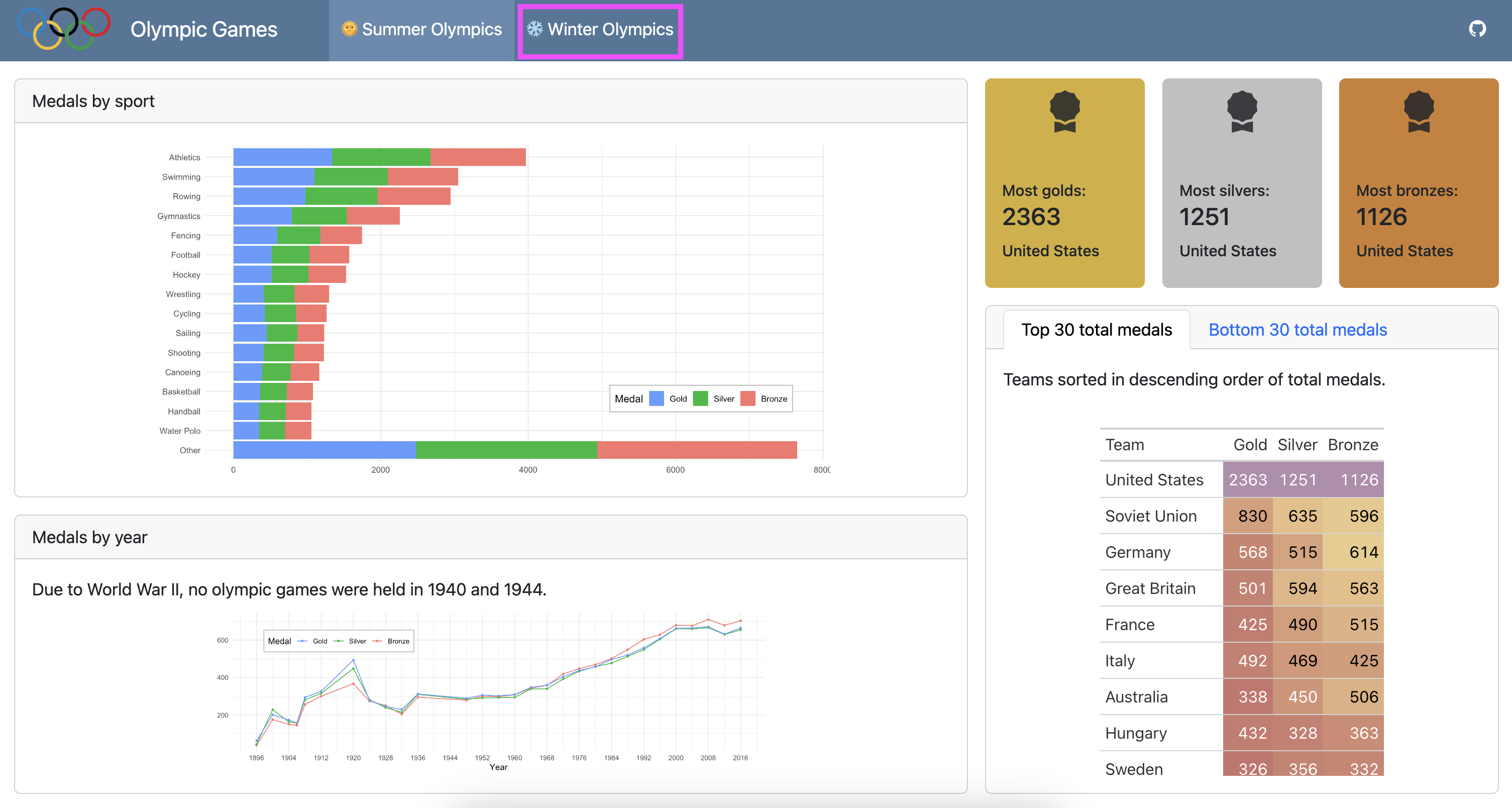
05:00
